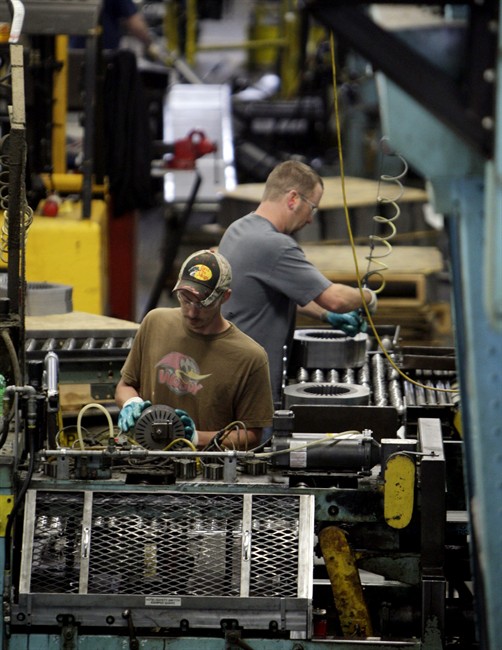WASHINGTON – The U.S. economy took a beating from an especially harsh winter during the January-March quarter, skidding into reverse for the first time in three years. But spring has arrived and along with it, signs that the chill was just a temporary setback in the long road to recovery.

Gross domestic product contracted at an annual rate of 1 per cent in the first quarter, the Commerce Department said Thursday. That was worse than the government’s initial estimate that GDP grew by a slight 0.1 per cent. The economy last posted a decline in the first three months of 2011 when it dropped 1.3 per cent.
Since then, the labour market has continued to improve, consumer spending is solid and manufacturers are benefiting from increased spending. Economists expect a robust GDP rebound in the April-June quarter as a result.
“We knew that weather dramatically impacted growth in the first quarter, and we fully expect a bounce back in the second quarter,” said Dan Greenhaus, chief strategist at BTIG, in a note to clients.
The government released a separate report Thursday reflecting progress. Applications for unemployment benefits, a proxy for layoffs, fell by 27,000 last week to 300,000. The result is nearly a seven-year low.
Ian Shepherdson, chief economist at Pantheon Macroeconomics, said that the big drop in unemployment benefit applications was more significant than the latest GDP figure because “it strongly supports the idea that the labour market conditions are improving markedly, despite the weak headline growth during the winter.”
- What is a halal mortgage? How interest-free home financing works in Canada
- Capital gains changes are ‘really fair,’ Freeland says, as doctors cry foul
- Budget 2024 failed to spark ‘political reboot’ for Liberals, polling suggests
- Tesla’s net income drops 55% in first quarter amid falling global sales
Other analysts noted that consumer spending, which accounts for 70 per cent of economic activity, was very strong in the first quarter, growing at an upwardly revised 3.1 per cent annual rate. A report earlier this week showed that consumer confidence is climbing, with nearly one-fifth of Americans expecting their incomes to grow over the next six months.
And earlier this month, the Institute for Supply Management said that manufacturing grew faster in April than March as exports picked up and factories accelerated their hiring.
The release Thursday was the government’s second look at first quarter GDP, the country’s total output of goods and services.
The data primarily reflected a sharp slowdown in businesses stockpiling, which subtracted 1.6 percentage points from growth, a full percentage point more than the initial estimate. Analysts noted that the weaker inventory figure would likely translate into more restocking and stronger growth in the second quarter.
The trade deficit was slightly larger than previously thought. Business investment in structures fell at an annual rate of 7.5 per cent in the first quarter, also worse than the initial estimate.
The 1 per cent decline in the first quarter was only the second negative quarterly GDP reading since the current recovery began in June 2009. In the fourth quarter, the overall economy grew at an annual rate of 2.6 per cent.
While one definition of a recession is two consecutive quarters of contraction in GDP, there is no concern that a negative reading in the first quarter is a sign the economy is about to topple into a downturn. The widespread view among analysts is that the weakness in the first quarter was based on a variety of one-time factors that will be quickly reversed as the weather warms.
Many economists estimate that GDP will post a sizable rebound to growth of around 3.8 per cent in the current April-June quarter, fueled by pent-up demand. Analysts are also optimistic that growth will remain above 3 per cent in the second half of this year, giving the economy the kind of strength that has been lacking for much of the first five years of recovery from the country’s worst recession since the 1930s.
If growth does pick up, that should promote stronger hiring and help drive the unemployment rate down further. In May, employers added 288,000 jobs in the biggest hiring surge in two years. That helped push the unemployment rate down to 6.3 per cent, its lowest point since 2008.
The economy is facing fewer hurdles this year than last year, when government spending cuts and higher taxes trimmed growth by an estimated 1.5 percentage points.
A government budget truce has also lifted, at least through the rest of this year, much of the uncertainty that had been weighing on the economy over the potential threats of further government shutdowns or market-rattling battles over raising the government’s borrowing limit.

Comments